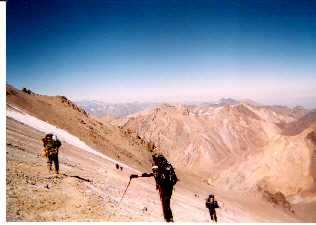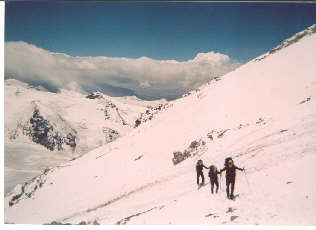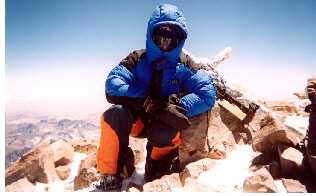Mountaineering Expedition 'Mulas Dragon 04' - Mount Aconcagua, Argentina- Jan / Feb 2004
21 Signal Regiment
Expedition Mulas Dragon was a High Risk and Remote level 3 adventurous training expedition to Argentina from 28 Jan – 21 Feb 2004. The aim was to reach the summit of mount Aconcagua via the Horcones valley approach following the normal route. At 6960m, Aconcagua is the highest mountain in the Americas and the highest in the Southern Hemisphere. Outside the Himalayan mountain range it is the highest mountain in the world.
The expedition challenged novice and experienced mountaineers, testing all to their personal limits. Although the Normal Route posed few technical challenges, the extreme altitude and weather patterns made the undertaking extremely demanding for everyone. The group was made up of a mixture of abilities, six personnel from 21 Signal Regiment (AS) and two attached instructors from 14 Sig Regt (EW) and the Honourable Artillery Company.
We deployed from the UK to Mendoza via Santiago in Chile, which is the heart of the wine region of Argentina. After many hours shopping in the local supermarket Capt Lindsey Courage and Capt Kate Hannaford did us proud by arranging all the rations for the mountain phase ahead. The next day we travelled by minibus to Puente del Inca at the bottom of the valley that lead to our objective. At Inca, we organised some mules to take our heavy loads along the 24km route to base camp (4350m).
 Aconcagua - lower slopes |
Climbing a mountain of this altitude requires a different strategy to, say, climbing Snowdon. Time has to be spent at altitude, slowly acclimatising, otherwise individuals can become extremely ill from simply climbing too high too soon; this can ultimately lead to death! We planned spending three days walking to base camp, followed by a rest day before proceeding to the next higher camp. The group would then sleep at the lower camp prior to moving up to the next higher camp that had been stocked up the previous day, sticking to the theory of climbing high and sleeping low. Once we were at camp 4 Piedras Blancas (white rocks, 6060m), the plan was to prepare for the 6 hr climb to the summit. Whilst at base camp, it was time to eat with a small ceremony in the field with Lt Kate Hannaford being promoted to Capt, with a kind letter and bottle of Champagne courtesy of the Commanding Officer. The alcohol quickly went to our heads enabling us to drift off into a peaceful night of sleep. As progress was made up the mountain from base camp to camp Canada, thence to Nido, Berlin and finally Piedras Blancas, the thin air and lack of oxygen made progress harder and harder. By this stage three members of the team, Capt Kate Hannaford, Cpl Julie West and Cpl Cheryl McMurray called it a day and returned to base camp. Above 5500m the body doesn’t acclimatise any more and, unless you’re a ‘Yeti’, a good night’s sleep is rare. As summit day approached, although the winds were extremely fierce, it was decided to go for it. After about 30 minutes into the summit attempt, myself and Tpr John Howie (HAC) decided to turn back as we could not feel our fingers and toes. It would take John over an hour to get the feeling back in his toes, and this really scared us. At 1330 hrs on 15 Feb 2004 Capt Lindsey Courage reached the summit of Aconcagua, together with a French mountain guide. With most of the group now safely back at base camp Flt Lt Bren Dunn and SSgt Mark Morgan decided to stay at Confluencia (6370m) and have another summit attempt. As we waited nervously at base camp, we learned that Bren made a successful attempt the following day. On arrival at base camp, Mark had to be treated for frostbite on all his fingers by the camp doctor; he also suffered from High Altitude Pulmonary Oedema (HAPE) whilst up the mountain. |
 Aconcagua - higher slopes |
|
 Aconcagua - summit |
The group then moved down to Puente del Inca. The walk back was further than we had remembered and took several hours, despite maintaining a rapid pace. After ‘booking out’ from the park entrance and collecting our kit from the mule company we bought a well deserved burger and beer! We all then returned back to Mendoza for the R&R phase of the expedition.
Two members of the party reached the summit of Aconcagua which is no mean feat. On a more favourable day with the weather, two or three other members could have also reached the summit; this was mainly due to the acclimatisation programme that worked extremely well.
Ex Mulas Dragon was extremely challenging and arguably the most ambitious adventurous training expedition the Regiment has attempted in recent years. The expedition achieved the aims which had been set, but most importantly, all team members enjoyed the adventure, worked close to their own personal limits and felt a real sense of achievement.
WO2 (RQMS) Angus MacPherson MBE